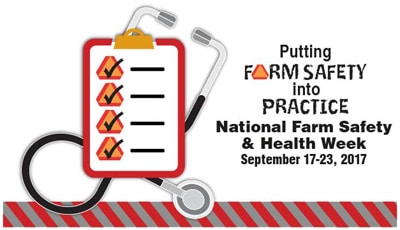National Farm Safety and Health Week 2017
Putting Farm Safety Into Practice
September 17-23, 2017
#FarmSafety #NFSHW

America’s farmers provide us with an abundant food supply. But farmers are exposed to a unique, sometimes hazardous workplace. Agriculture continues to rank as one of the most dangerous occupations in North America and across the globe.
National Farm Safety and Health Week is September 17-23, 2017. This year’s theme is “Putting Farm Safety into Practice”.
The National Education Center for Agricultural Safety (NECAS), UMASH, and the US Agricultural Centers funded by the National Institute for Occupational Safety and Health (NIOSH) are spotlighting agricultural health and safety with a variety of resources for farm workers, their families, and everyone involved in agriculture.
DAILY THEMES
| MONDAY | Tractor Safety (with an emphasis on the ROPS rebate program) |
| TUESDAY | Farmer Health |
| WEDNESDAY | Children’s Health and Safety |
| THURSDAY | Confined Spaces in Agriculture |
| FRIDAY | Rural Roadway Safety |
AGRISAFE WEBINARS
AgriSafe Network will be conducting daily webinars to inform professionals, as well as Agricultural producers on important agricultural occupational health and safety topics.
RESOURCES
- 2017 NFSHW Logo (color) (grayscale)
- 2017 NFSHW Flyer (English) (Spanish)
- How are you advocating for farm safety? Find ideas in our social media kit! (English) (Spanish)
- 2017 NFSHW Press Release
- Wisconsin Governor Proclaims WI Farm Safety and Health Week
- Farm Safety and Health Week PSA (wav) (mp3)
- UMASH Farm Safety Checklist
The UMASH Farm Safety Check is a quick monthly review to identify and fix potential hazards before they cause harm to your family and employees – and your bottom line. Each month, Farm Safety Check will focus on a different topic, offering checklists and tips to help identify hazards, along with resources to remedy any problems. - UMASH Resource Database
Download agricultural safety and health resources created by UMASH, our pilot project programs, and collaborating institutions - UMASH Ag Safety and Health Spotlight
UMASH Ag Safety and Health: Stories from the Field highlights the stories of farmers and farm families – their experiences with injury or disease on the farm, as well as what they learned and suggestions for prevention.

 Wednesday, September 20
Wednesday, September 20